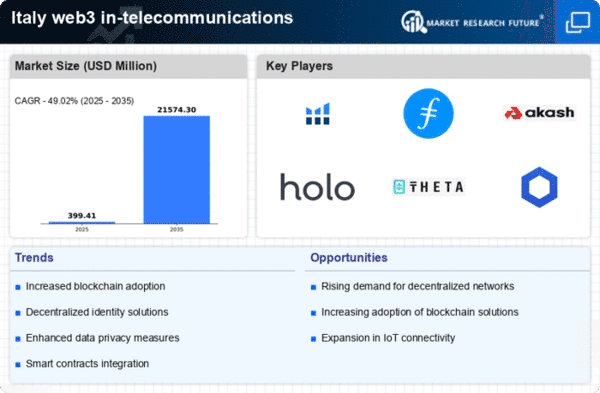The web3 in-telecommunications market is currently characterized by a dynamic competitive landscape, driven by rapid technological advancements and increasing demand for decentralized communication solutions. Key players such as Helium (US), Filecoin (US), and Theta Network (US) are strategically positioning themselves through innovative approaches and partnerships. Helium (US), for instance, focuses on expanding its decentralized wireless network, which allows users to earn tokens by providing coverage. This strategy not only enhances its service offerings but also fosters community engagement. Similarly, Filecoin (US) emphasizes its decentralized storage solutions, which are increasingly sought after as data privacy concerns grow. Theta Network (US) is leveraging its blockchain technology to enhance video streaming services, indicating a trend towards integrating web3 capabilities into traditional telecommunications frameworks. Collectively, these strategies are reshaping the competitive environment, pushing for a more decentralized and user-centric approach in telecommunications.
In terms of business tactics, companies are increasingly localizing their operations and optimizing supply chains to enhance efficiency and responsiveness. The market structure appears moderately fragmented, with several players vying for dominance while also collaborating on various initiatives. This fragmentation allows for a diverse range of services and innovations, although it also presents challenges in terms of standardization and interoperability among different platforms.
In October 2025, Helium (US) announced a partnership with a major telecommunications provider to expand its network coverage across urban areas in Italy. This strategic move is significant as it not only enhances Helium's market presence but also validates the potential of decentralized networks in urban settings, where traditional infrastructure may be lacking. The collaboration is expected to drive user adoption and increase the utility of Helium's services, positioning the company favorably against competitors.
In September 2025, Filecoin (US) launched a new initiative aimed at integrating its storage solutions with existing telecommunications infrastructures. This initiative is crucial as it addresses the growing need for secure and efficient data storage solutions in the telecommunications sector. By aligning its offerings with the needs of telecom operators, Filecoin is likely to enhance its market relevance and attract new partnerships, thereby strengthening its competitive position.
In August 2025, Theta Network (US) introduced a new feature that allows content creators to monetize their streams directly through blockchain technology. This development is particularly relevant in the context of the increasing demand for decentralized content distribution. By empowering creators and enhancing user engagement, Theta Network is not only differentiating itself from traditional streaming services but also reinforcing the value proposition of web3 technologies in telecommunications.
As of November 2025, the competitive trends in the web3 in-telecommunications market are increasingly defined by digitalization, sustainability, and the integration of AI technologies. Strategic alliances among key players are shaping the landscape, fostering innovation and collaboration. Looking ahead, it appears that competitive differentiation will evolve from traditional price-based strategies to a focus on technological innovation, reliability in supply chains, and enhanced user experiences. This shift suggests a promising future for companies that can effectively leverage their technological capabilities to meet the evolving demands of the telecommunications market.

















Leave a Comment